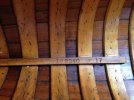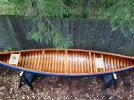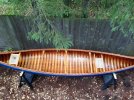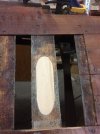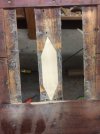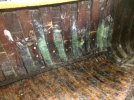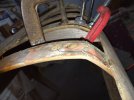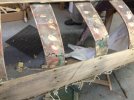You are using an out of date browser. It may not display this or other websites correctly.
You should upgrade or use an alternative browser.
You should upgrade or use an alternative browser.
Old Town?
- Thread starter Lindemanlax
- Start date
Lindemanlax
Canoeing the Northern Neck of Virginia
Thanks. I hadn’t noticed the floor until you mentioned it. Still waiting to see it in person. — and for the seller to state the asking price. I was told it would need re-canvassing. Are there any restorers for these canoes in Virginia, do you know? And, what should a re-canvas cost? just trying to understand all costs as I walk into this. Thanks again for your help!
Lindemanlax
Canoeing the Northern Neck of Virginia
We’re in Lancaster, Va. near Kilmarnock.
Lindemanlax
Canoeing the Northern Neck of Virginia
Will do. Thanks!
Welcome, the Old Town canoe with serial number 199340 is a 17 foot long Otca model with a keel, outside stems, a bang plate along the full length of the keel, two painter rings, and a floor rack. It was built between February and April, 1974. The original exterior paint color was Yale blue. It shipped on April 19th, 1974 to Ellicott City, Maryland. The back side of the record shows that the warranty card was returned from Baltimore, Maryland on September, 11th, 1974. Scans showing both sides of this build record can be found below.
These scans and several hundred thousand more were created with substantial grants from the Wooden Canoe Heritage Association (WCHA) and others. A description of the project to preserve these records is available at http://www.wcha.org/catalogs/old-town/records/ if you want more details. I hope that you will donate, join or renew your membership to the WCHA so that services like this can continue. See https://www.woodencanoe.org/about to learn more about the WCHA and https://www.woodencanoe.org/shop to donate or join.
It is possible that you could have another number or manufacturer if this description doesn't match the canoe. Feel free to reply here if you have any other questions.
Benson


These scans and several hundred thousand more were created with substantial grants from the Wooden Canoe Heritage Association (WCHA) and others. A description of the project to preserve these records is available at http://www.wcha.org/catalogs/old-town/records/ if you want more details. I hope that you will donate, join or renew your membership to the WCHA so that services like this can continue. See https://www.woodencanoe.org/about to learn more about the WCHA and https://www.woodencanoe.org/shop to donate or join.
It is possible that you could have another number or manufacturer if this description doesn't match the canoe. Feel free to reply here if you have any other questions.
Benson
Last edited:
Lindemanlax
Canoeing the Northern Neck of Virginia
Benson, thank you so much! This helps greatly — And does match the boat in question. Hopefully, I’ll get to see it this week and be able to make an assessment. I’ll keep y’all posted. Thanks again. For your help. It’s greatly appreciated!
Lindemanlax
Canoeing the Northern Neck of Virginia
@Benson Gray do you know of any restoration craftsmen in Virginia? The owner of this OTCA says there are several cracked ribs that need addressing, which is beyond my skill level. I'm going to look at it on Sunday, so hope to know more then -- and hopefully brig her home. Thanks in advance for your help!!!
Also -- I just joined WCHA. Looking forward to all the collective experience out here!
Also -- I just joined WCHA. Looking forward to all the collective experience out here!
do you know of any restoration craftsmen in Virginia?
The list at the link below has many fine restorers but none of them are in Virginia so you may need to travel a bit. Good luck,
Benson
BuildersSuppliers
Whether you're looking to have a canoe restored, or to find the products or information to restore it yourself, you'll find what you need in our Builders and Suppliers listing.
 www.woodencanoe.org
www.woodencanoe.org
Lindemanlax
Canoeing the Northern Neck of Virginia
Thanks! I scoured the list. Sadly, none in Virginia. I live near the Chesapeake Bay, so I'm also searching wood boat builder sources locally. Hopefully, someone will pop up. Replacing/scarfing in canoe ribs can't be much different than doing so on any wooden boat. Thanks again!
Dave Osborn
LIFE MEMBER
Rib repair will cause you to need to replace the canvas, (at least proper rib repair/replacement). That will take the idea of varnishing the hull out of the question, unless you prefer to use as is with the ribs as is.
Lindemanlax
Canoeing the Northern Neck of Virginia
@Dave Osborn, I saw a post out here where someone used epoxy/glass to patch over the broken rib(s) until the canvas needed to be replaced (when replacing the affected ribs would be easier) and it worked fine. Perhaps that's the easy option that would be less evasive and buy me a few years..? I'm not looking for this to be a show piece. I want to paddle it and then when a proper restore is needed, do it right then.
paddler123
Enthusiastic about Wooden Canoes
If you want to do a functional rib repair without recanvassing, the best way to do that is to sister in a piece of rib stock (maybe 8-10"?) on the inside with screws. You may need to steam it if it's in a curved part of the rib. Alternatively, if it's just one or two ribs and there's no major deformity, you can leave it be. Do you have pictures of the damaged areas?
Lindemanlax
Canoeing the Northern Neck of Virginia
@paddler123, this is the only pic I have. Looks like maybe 6-8 cracked ribs. Rather than sister these, could I bed some epoxy and 2 sheets of glass to cover the cracked areas? Again, just to hold me over until the canvas needs replacing down the road?
Attachments
paddler123
Enthusiastic about Wooden Canoes
You definitely don't want to epoxy anything to the inside - the damage it will cause to remove it isn't worth it. And I don't think putting glass on the outside would add meaningful strength, since the canvas isn't adhered to the hull except at the gunwales. From the picture, it looks like it's probably usable as is, as long as you're not too rough with it. The important thing to look at would be any major changes to the shape of the hull from the outside, or corresponding tears in the canvas where the ribs are broken. The waterproof hull of a W/C canoe is the canvas - the wood is just there to give it structure. So as long as the canvas doesn't leak (too much), it should be fine.
Lindemanlax
Canoeing the Northern Neck of Virginia
@paddler123, thanks. I was just thinking of epoxying/glassing the cracked ribs themselves, and just a few inches of either side of the cracks -- not the planking or the exterior hull. So, just making an epoxy/glass "band aid", if you will, on top of the rib itself, to provide strength to the cracked ribs -- just until it's time to replace them during re-canvassing down the road. According to the owner, it doesn't leak, so there should be any penetration of the canvas in these areas. If I bring it home on Sunday when I go to look at it, I'll take better pics to show the damage. Thanks for your guidance!
paddler123
Enthusiastic about Wooden Canoes
You likely could, but that sounds like more effort than it's worth. I'd probably just paddle it as is. Most of my paddling has been with summer camps, with canoes that don't look like the immaculately restored ones you often see here. A few minorly broken ribs and/or planks don't really affect the paddling experience, and you can always fix it later down the road if you decide to recanvas.
Dave Osborn
LIFE MEMBER
its likely the cracks could be repaired with a backside rib repair prior to recanvassing. That adds the necessary strength and brings the original rib back to form. Should you put epoxy and glass on them, it will cause them to need to be totally replaced because it’s doubtful that the glass patches can be removed without damage.
More photos will give a better idea of what is needed, either backside repair, or total replacement.
Personally I opt for a backside repair when it’s appropriate. It saves the original rib.
More photos will give a better idea of what is needed, either backside repair, or total replacement.
Personally I opt for a backside repair when it’s appropriate. It saves the original rib.
Attachments
Similar threads
- Replies
- 2
- Views
- 1K
- Replies
- 4
- Views
- 4K

